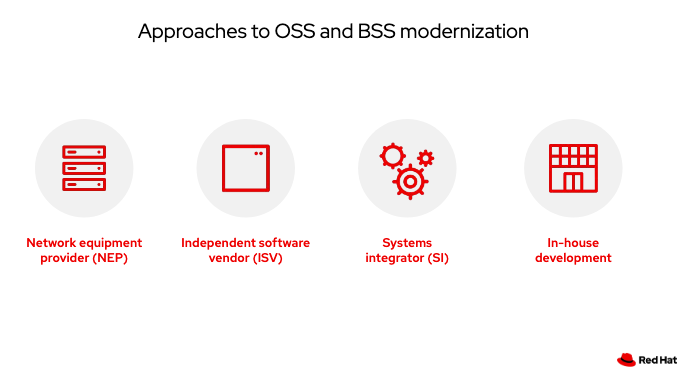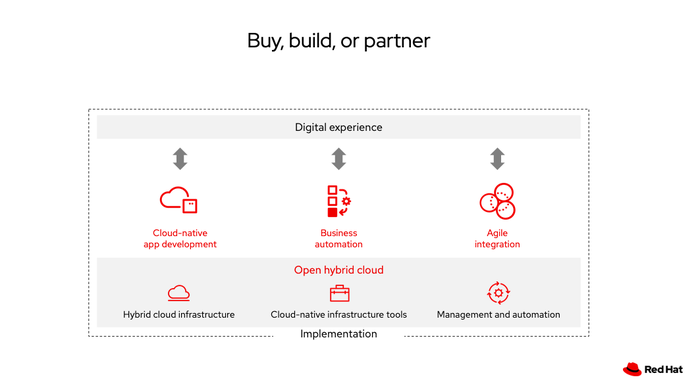Transforming your OSS BSS - new options for new realitiesTransforming your OSS BSS - new options for new realities
August 10, 2021

This Vendor View is sponsored by Red Hat
The last 18 months have certainly been a challenge, thanks to the global pandemic, requiring extraordinary resilience in adapting to a “new normal.” While we must never forget the role healthcare workers, scientists and leaders played in keeping us safe, we certainly need to recognize the communications service providers (CSPs) who kept us all connected as we dispersed in many directions – whether working from home, video calling friends and family, or stressing video conference systems with remote yoga sessions. We have shared case studies of how network virtualization helped agile CSPs shift and scale network resources quickly where they were needed – setting up online storefronts for some retailers, for example, and accommodating the explosion of ecommerce traffic overall as retailers continued to serve customers after having to close brick and mortar stores.
Was this a one-time event? Is this new reality permanent or will we go in full reverse to the “old normal” as countries open up? Those answers are up for interpretation, but either way, we’ve learned how mobile and flexible service providers can be. To manage dynamic conditions such as these more efficiently, service providers have learned that they need to adapt their operations and business support systems (OSS and BSS) to be more agile. Doing so will also enable them to take advantage of myriad new 5G service capabilities.
What are your options to transform your OSS and BSS?
The options might appear very similar to previous implementations but with a twist. Network equipment providers are not only reconfiguring existing resources, but are also modernizing their products to utilize and support new technologies and associated capabilities. The ecosystem of independent software vendors (ISVs) keeps growing with many new startups. They offer innovative solutions ranging from real time charging and cloud based assurance to AI-based solutions aiding the interpretation of a growing amount of network data. As large networks become more complex, system integrators can take charge of integrating multi-vendor and multi cloud networks for CSPs. And many CSPs will choose to invest in services differentiation through in-house development to gain a competitive edge.

So what is the twist?
The means to accommodate growing complexity while increasing the speed of innovation and service delivery is to unite all the options with a common application platform providing consistent development and operations tooling and processes. Doing so will mitigate the risk of developing innovative, yet isolated solutions, any of which might not be able to fully benefit from other platform components. We outlined the architecture implementing this platform in a series of webinars previously, and this approach is even more relevant since we have expanded the breadth of capabilities.
Beyond the principal challenges of implementing, operating and monetizing 5G, service providers must integrate many new OSS and BSS solutions while maintaining or upgrading legacy networks and support systems. To help address these, we recommend a common, telco-grade application platform. This platform must enable cloud-native application development and deployment, maximum levels of automation, and deep integration of current and new systems. It must have the ability to run all of it across a hybrid or multi-cloud environment reliably and securely. Such an application platform will allow CSPs, vendors and system integrators to focus on innovations in their core areas of expertise. Digital transformation success certainly depends on new technology but it depends even more on the way in which that technology is implemented, and the adoption of associated (improved) operational processes. These factors are why Red Hat helps service providers build and utilize their cloud native application platforms across private and public clouds with higher efficiency and capability.

What are the new OSS/BSS solutions and trends?
Presently, ACG Research estimates about 30% of newly deployed OSS and BSS solutions are cloud based. By 2025, that figure is anticipated to rise to 90%, and most CSPs will have plans for the eventual phaseout of OSS/BSS that are not cloud-native. There’s no debate about whether these systems are going cloud-native; it is a question of when and how fast. Digital service providers must transition to cloud native OSS and BSS solutions to compete, innovate and meet increasing customer expectations. Red Hat and its ecosystem partners solutions are innovating at a rapid pace. We’ve shared the most recent developments and case studies at several of this past year’s events like Open5GCon, AnsibleFest, and Red Hat Summit. You can watch sessions online from these virtual events at your convenience to understand the value these solutions can bring.
Together with ACG Research and Intel, we have highlighted a few Red Hat partners to showcase innovation and modernizing of OSS and BSS solutions.
Cloud-native developmentAmdocs shares insights on why and how they shifted Amdocs MS360 to a cloud-native development platform. The increased speed of innovation and faster rollout of new capabilities directly benefits their CSP customers. They no longer deliver new capabilities in only one or two releases per year, but instead release them more frequently as they become available, enabling CSPs to respond to new opportunities and customer needs much faster.
Innovation for monetizing 5G networks and services.Matrixx Software offers a cloud-native real-time charging platform that enables CSPs to create innovative and highly flexible billing options for their customers. MATRIXX Software exploits new cloud software technologies to create a remarkably agile system with the ability to launch and modify novel services in a matter of weeks rather than months.
The migration of services to multi-cloud environments.MYCOM OSI has moved service assurance to the cloud. Many thought that assurance would be the last service moving to the cloud, but MYCOM OSI has proven its value as a solution presently available. The MYCOM OSI service assurance platform and applications were developed and widely deployed before the general availability of cloud-native software technology. The company now has transitioned to a full cloud-native architecture over the last five years. CSPs can benefit from the system’s ability to dynamically scale in times of maximum demand from major network events, ensuring excellent real-time performance.
These are only a few examples of Red Hat’s large OSS/BSS partner ecosystem that leverage the benefits of an open cloud-native application platform for faster innovation and service rollout.
To learn more about building a strong foundation for your cloud-native OSS and BSS solutions, please visit the Red Hat telecommunications resource hub, or talk with your Red Hat representative or partner.
Read more about:
Vendor SpotlightsAbout the Author
You May Also Like











.png?width=300&auto=webp&quality=80&disable=upscale)


_1.jpg?width=300&auto=webp&quality=80&disable=upscale)